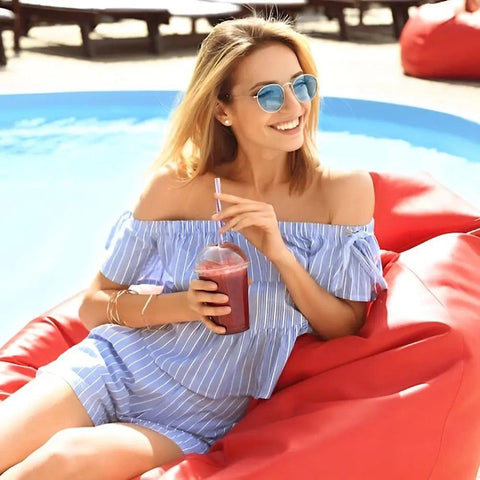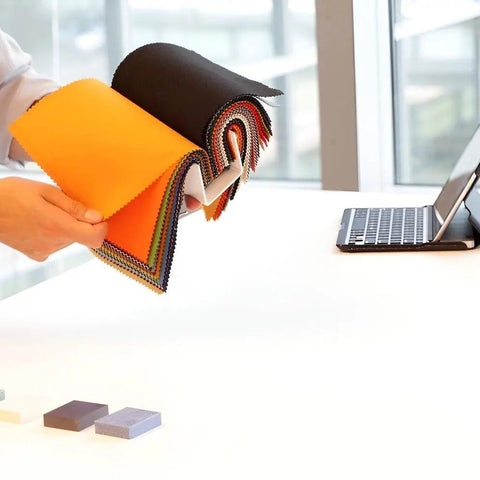When it comes to premium outdoor furniture, two fabrics stand out as the best. Discover everything you need to know about Olefin vs. Sunbrella fabric.
Like most Aussies, you probably love making the most of the warm, sunny weather every summer. Whether you own a swimming pool or hit the beach, the right poolside chairs can make a big difference in comfort and enjoyment. Investing in a pool bean bag or outdoor bean bag by Bean Bags R Us is a smart move, but it’s also important to understand the differences between the most popular outdoor fabrics. In this post, we’ll compare two leading options: Olefin and the well-known solution-dyed acrylic fabric, Sunbrella. This article will examine the primary distinctions between Olefin and Sunbrella fabrics for outdoor furniture. So, who wins in the Olefin vs Sunbrella fabric debate? And where can you find the best outdoor bean bag chairs?
Exposure to the Elements: How Outdoor Fabrics Perform
Most fabrics don’t hold up well outdoors. Making the right fabric choices is crucial for the longevity of outdoor furniture, as materials like cotton and nylon fade quickly due to exposure to UV rays, saltwater, and chlorine. After investing in outdoor pool chairs or furniture, you want them to look great for years to come. To achieve this, avoid fabrics like nylon and canvas and choose materials specifically designed for outdoor use. These specialised fabrics resist fading and deterioration, maintaining vibrant colours and patterns much longer. In contrast, standard fabrics and other less suitable materials for outdoor use, such as Sunbrella, can quickly become bleached, thin, and worn, leading to tearing and damage.
Modern Technologies in Outdoor Fabrics
Historically, cotton was the go-to material for outdoor use, but it faded and wore out quickly. The development of new fibres and materials, especially synthetic fibres and acrylic fabrics, in the mid-20th century transformed outdoor furniture, offering improved strength, durability, and colourfastness.
What to Look for in Quality Outdoor Furniture
When shopping for outdoor bean bags and furniture, look for these fabric properties:
-
UV resistance
-
Colourfastness and fade resistance
-
Water resistance
-
Durability
-
Comfort
-
Stain resistance
-
Style and appearance
-
Eco-friendliness
-
Resistance to mildew, insects, and chemicals
-
Ease of maintenance and cleaning: Some fabrics, such as Olefin, are known for their minimal maintenance requirements. They typically need only basic cleaning with mild soap and water, and can withstand harsher cleaning if needed, making upkeep simple and low-effort.
-
Variety: Olefin fabrics come with a wide range of colours, weaves, and textures.
The Importance of Solution-Dyed Fabric
Another key factor is how outdoor fabrics are dyed. Affordable materials like nylon and polyester are piece-dyed, meaning only the surface is coloured. Solution-dyed fabrics, however, have fibres dyed all the way through, making them much more resistant to UV rays, chlorine, and saltwater, and helping them maintain their style and appeal for longer. In contrast, other outdoor fabrics may not provide the same level of UV and colourfastness.
Sunbrella: The Leading Solution-Dyed Acrylic Fabric
For decades, Sunbrella has been the top choice for outdoor furniture, with Sunbrella outdoor fabrics widely recognised for their high performance. Sunbrella is the brand name for the most popular solution-dyed acrylic fabric, used in everything from awnings to outdoor furniture, such as bean bags. Developed in the 1960s by Glen Raven, Sunbrella set the standard for durable, colourfast outdoor fabrics. Sunbrella offers a wide range of outdoor fabrics with specific warranties and features, including durability, UV resistance, water resistance, and easy cleaning. It is made of 100% solution-dyed acrylic, designed specifically for outdoor use. Sunbrella fabrics are known for their exceptional durability, are UV resistant, and can last for many years, even in harsh outdoor environments.
How Sunbrella Fabric is Made
Sunbrella is made from acrylic, a synthetic fabric created from polyacrylonitrile. Acrylic is soft, mildew-resistant, cool in direct sunlight, and quick-drying. Solution dyeing adds colour to the chemical solution before it’s spun into fibres, resulting in exceptional colourfastness and durability, and also helps prevent mildew growth.
Benefits of Sunbrella
-
Fade-resistant: Withstands up to 1,500 hours of sun before fading.
-
Water-resistant: Not fully waterproof, but resists moisture well.
-
Mildew-resistant: Its water resistance helps prevent mildew growth.
-
Comfortable: Softer than canvas and polyester.
-
Cool: Remains cool even in direct sunlight.
-
Durable: Strong and resilient thanks to its unique chemical process.
-
Stylish: Available in a wide range of colours and patterns.
-
Weather-resistant: Sunbrella is resistant to a wide range of weather conditions, including prolonged sun exposure and heavy rainfall.
-
Ideal for outdoor applications: Perfect for cushion covers, rugs, umbrellas, and furniture covers due to its weather resistance.
Drawbacks of Sunbrella
Sunbrella is the most expensive outdoor fabric, and products made from it are pricier. However, the higher cost is often justified for patio furniture that requires long-term durability and weather resistance. It’s not as soft as Olefin, can transmit static electricity, and is less eco-friendly and recyclable than some alternatives. While Olefin is initially more budget-friendly, Sunbrella’s longer lifespan often makes it a better long-term investment.
Olefin: Eco-Friendly and Affordable Outdoor Fabric
Olefin, made from polypropylene fibre, is a synthetic fibre developed in 1957 by Italian chemist Giulio Natta. The process upcycles a byproduct of oil production, making Olefin an environmentally friendly choice. It’s used in many pool and outdoor bean bags by Bean Bags R Us. Olefin fabric is primarily made from ethylene and propylene and is also considered a solution-dyed fabric. The manufacturing of Olefin is much more environmentally friendly than most fabric production.
How Olefin Fabric is Made
Polypropylene is derived from propylene gas, a byproduct of oil and ethylene production. The gas is polymerised into beads, melted, and spun into thread. Solution-based dyes are added during the melting process, resulting in highly colourfast and stain-resistant fabric.
Benefits of Olefin
-
Affordable: Less expensive to produce than Sunbrella.
-
Eco-friendly: Upcycles waste, uses no land or water, and is highly recyclable.
-
Comfortable: Soft, smooth, and does not transmit static charges.
-
Water-resistant: Wicks away moisture and dries quickly.
-
Durable: Highly resistant to abrasion.
-
Colourfast: Solution-dyed for long-lasting colour.
-
Versatile: Available in many colours and patterns, making Olefin an excellent choice for outdoor cushions, outdoor cushion covers, and outdoor cushions due to its durability and weather resistance.
-
Resistant to mildew, chemicals, and insects; easy to clean.
Drawbacks of Olefin
Olefin is sensitive to extreme heat and can melt at high temperatures, so it should be air-dried. Its performance diminishes in extreme heat conditions. It’s naturally sensitive to sunlight, but UV inhibitors are added during the processing stage. Olefin outdoor fabrics can show wear and tear in high traffic areas, unlike Sunbrella fabrics, which hold up better under frequent use.
Style and Appearance: Design Possibilities with Olefin and Sunbrella
When it comes to creating a beautiful and inviting outdoor space, the style and appearance of your outdoor furniture fabric play a crucial role. Both Olefin and Sunbrella fabrics offer a wealth of design possibilities, making it easy to find the perfect match for your patio, deck, or poolside area. Sunbrella fabrics are especially renowned for their vibrant colours and exceptional durability, ensuring your outdoor furniture cushions and covers stay looking fresh and stylish season after season. With Sunbrella, you can choose from a wide array of bold hues, sophisticated patterns, and luxurious textures that bring personality and flair to any outdoor setting.
Olefin fabrics, although often more understated, offer a sleek and modern look that complements a wide range of outdoor furniture styles. Their subtle tones and soft textures create a relaxed, contemporary vibe, while still delivering superior UV resistance and water resistance. Whether you prefer the eye-catching appeal of Sunbrella or the minimalist elegance of Olefin, both fabrics allow you to customise your outdoor furniture to reflect your personal taste. With numerous options available, you can easily coordinate your outdoor furniture cushions, bean bags, and covers to create a cohesive and stylish outdoor space that withstands the elements.
Budget and Cost: Comparing Affordability and Value
Budget is always a key consideration when selecting the best fabric for outdoor furniture. Olefin and Sunbrella fabrics each offer distinct advantages in terms of affordability and long-term value. Olefin fabrics are generally more budget-friendly, making them an excellent choice for those seeking to furnish their outdoor space without overspending. This makes Olefin ideal for outdoor furniture that may see less frequent use or for areas that are more sheltered from harsh weather conditions.
On the other hand, Sunbrella fabrics come with a higher upfront cost, but their exceptional durability, superior UV resistance, and water resistance make them a smart investment for quality outdoor furniture that needs to withstand the rigours of outdoor use. The long-lasting nature of Sunbrella means you may save money in the long run by avoiding frequent replacements or repairs. When weighing Olefin vs Sunbrella, consider how often your outdoor furniture will be used, the level of exposure to sun and rain, and your willingness to invest in premium outdoor furniture fabric. By balancing your budget with your needs for durability and weather resistance, you can choose the best fabric that delivers both value and performance for your outdoor living area.
Olefin vs Sunbrella: Which is Best?
-
Durability: Olefin is more abrasion-resistant.
-
Water-resistance: Sunbrella is slightly more water-resistant, but Olefin wears better over time.
-
Style: Both offer a wide range of colours and patterns.
-
UV and fade resistance: Both are highly fade-resistant due to solution dyeing and exhibit qualities that make them resistant to mould growth.
-
Eco-friendliness: Olefin is a more sustainable and recyclable material.
-
Comfort: Both are comfortable, but Olefin doesn’t transmit static.
-
Stain resistance: Both are highly stain-resistant.
-
Maintenance: Both are easy to clean, making them ideal for cushion covers and outdoor furniture covers, but Olefin should be air-dried.
For regular maintenance, both Sunbrella and Olefin fabrics can be spot cleaned with a mild detergent and a damp cloth. For stubborn stains, harsh chemicals like bleach can be used without damaging the fabric.
Both fabrics resist mildew growth and are designed to withstand UV exposure, helping to prolong their lifespan and maintain their appearance in outdoor environments.
The Sunbrella vs Olefin debate centres on these key differences and similarities, helping you choose the best option for your outdoor needs.
Bean Bags R Us: Premium Olefin and Sunbrella Outdoor Bean Bags
Bean Bags R Us offers a wide range of outdoor and pool bean bags, as well as outdoor cushions made from Olefin and solution-dyed acrylics, such as Sunbrella. For poolside comfort and durability, our Portsea Premium bean bag pool float(featuring Olefin) is a standout. Our Copacabana and Costa Luxe outdoor bean bags are also top choices. Both Sunbrella and Olefin are reliable for outdoor furniture and outdoor cushions, but Olefin stands out for its affordability, comfort, eco-friendliness, and water resistance. Cleaning both Sunbrella and Olefin fabrics requires only mild soap and water, with occasional spot cleaning as needed.





